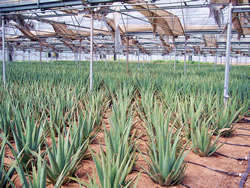Aloe Vera Scientific Studies
by Bill Wolfe DDS

Aloe vera plants for Dr. Wolfe’s products are organically grown in climate controlled greenhouses.
Bactericidal Studies
Various percentages of Aloe Vera gels were tested in culture media consisting of the following organisms: Staphylococcus aureus, Streptococcus viridans, Candida albicans, Corynebacterium xerosis, and the five strains of Streptococcus mutans most commonly found in dental plaque. The gel was bactericidal against the above bacteria and fungicidal against Candida albicans (the cause of moniliasis or ‘denture sore mouth.’) An important finding by Zimmerman was that the dramatic effects of the aloe gel were not apparent until there was at least a 70% concentration of the gel. To achieve a 70% or greater concentration, an Aloe Vera gel must be stabilized with anti-oxidants in order to minimize the otherwise necessary preservatives which lessen the percentages of Aloe Vera in the product.
Virucidal Studies
The Aloe Vera gel formula was found to be virucidal against Herpes simplex and Herpes zoster viruses.
Anti-inflammatory Studies
Prednisolone and Indomethacin (common anti-inflammatory drugs) were utilized in a comparative study with the Aloe Vera gel to observe the effects on tissue culture cells. The gel was found to be just as effective as Prednisolone and Indomethacin, without having the long term toxicity of either drug.
Cell Cytotoxicity Studies
Human embryonic kidney cells (HEK cells) were utilized to determine the effectiveness of aloe gel on cellular longevity. The cellular death rate was found to be reduced by 2/3 when cultured with the aloe gel. Note: It is important to acknowledge research by Dr. Wendell Winters, Associate Professor of Microbiology at the University of Texas Health Science Center, San Antonio, Texas. Dr. Winters found that although Aloe Vera promoted the growth and healing of healthy human cells, the gel did not have the unwanted effect of stimulating the growth of cancer cells.
Dr. Zimmerman’s studies proved the Aloe Vera gel formula to be nontoxic, bactericidal, virucidal, and fungicidal against a broad range of micro-organisms, and a stimulator of cellular life-extension. This research and the clinical effects which I had witnessed in my office resulted in a commitment on my part to discover the uses of the aloe gel in all aspects of dental health. Now that I had laboratory and clinical evidence of the effectiveness and biocompatibility of my Aloe Vera formula, I felt that the next step for oral health should be to develop an Aloe Vera-based toothpaste.
Because a toothpaste or a tooth gel must include abrasives (of which examples are listed below), a surface active agent (foaming agent), a sweetener to counter the taste of the various ingredients (including the pungent taste of aloe gel), and a breath freshener, I was concerned about how much the healthful properties of the gel might be compromised by being combined in such a formula.
| Abrasive | Surface loss of Enamel |
|---|---|
| Flour of pumice | .300 (highest index of abrasiveness) |
| Alumina | .300 |
| Tin Oxide | .083 |
| Calcium Carbonate | .012 |
| Magnesium Trisilicate | .009 |
| Calcium Pyrophosphate | .005 |
| *Hydrated Silica | .002 |
| Sodium Metaphosphate | .001 |
| Tribasic Calcium Phosphate | .001 (lowest index of abrasiveness) |
The bactericidal effects on dental plaque are a primary concern in evaluation and measuring the effectiveness of a toothpaste. Such bactericidal potency can be measured in the laboratory by means of a ‘sensitivity disc’ method of analysis. This method utilizes agar plates (“Petri” dishes) upon which are grown bacterial cultures of the various micro-organisms to be tested. The next project tested the Aloe Vera toothpaste formula against the various bacterial components of dental plaque (LM-7, BHT, AHT, 6715, and GS-5 strains of Streptococcus mutans bacteria.) After two hours of incubation, sterile paper discs were placed on the inoculated dishes. On each disc 0.3 grams of sample toothpaste was used in each experiment.
Each dish was examined after 24 and 48 hours to detect zones of clearing for inhibition (kill) of the Streptococcus mutans bacteria. The measurement from the edge of the disc to the end of the clear zone surrounding the disc indicates the depth of ‘kill’ of the bacteria, i.e., the larger the number of millimeters, the more potent the bactericidal effects. The chart below demonstrates the results after 48 hours of bactericidal analysis, comparing the Aloe-DentTM formula to Crest® and Colgate® toothpastes.
| Streptococcus Mutans Bacteria Strain Numbers After 48H | Aloe-DentTM | Crest® | Colgate® |
|---|---|---|---|
| LM-7 | 16mm | 9mm | 11mm |
| GS-5 | 15mm | 12mm | 13mm |
| 6715 | 10mm | 11mm | 9mm |
| BHT | 20mm | 10mm | 14mm |
| AHT | 16mm | 16mm | 10mm |
This chart demonstrates the bactericidal effectiveness of Aloe-DentTM against the 5 strains of Streptococcus mutans bacteria in dental plaque. The fact that the Aloe-DentTM range was greater than that of either Crest® or Colgate® is very noteworthy, as the bactericidal results from the Crest® and Colgate® testing are due to fluoride. Aloe-DentTM was able to achieve equal or better results without the addition of fluoride, which is controversial due to its wide range of potentially harmful systemic effects.
Conclusion
The previous research is only a partial indication of the potential benefits which Aloe Vera can provide for dentistry. I encourage health professionals to investigate, experiment, and conclude for themselves as to the effectiveness, new uses, and exciting future which Aloe Vera has in dentistry.
References: